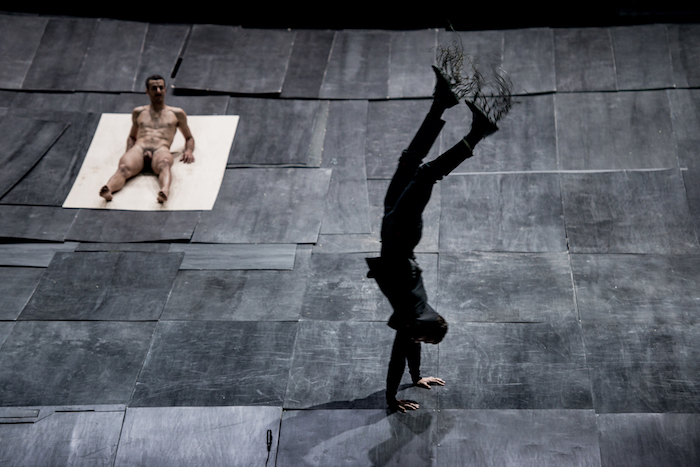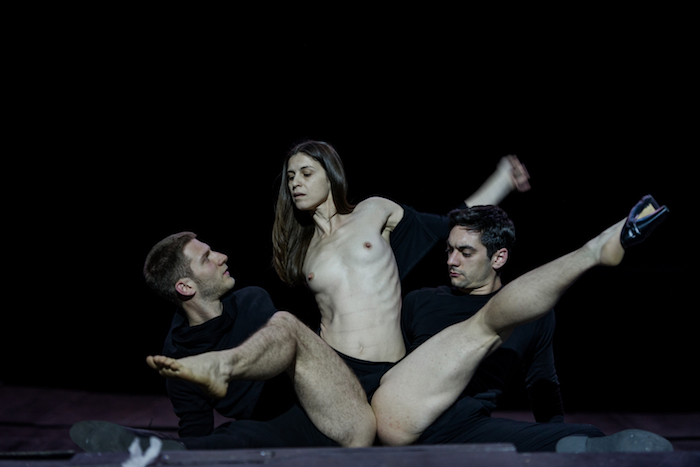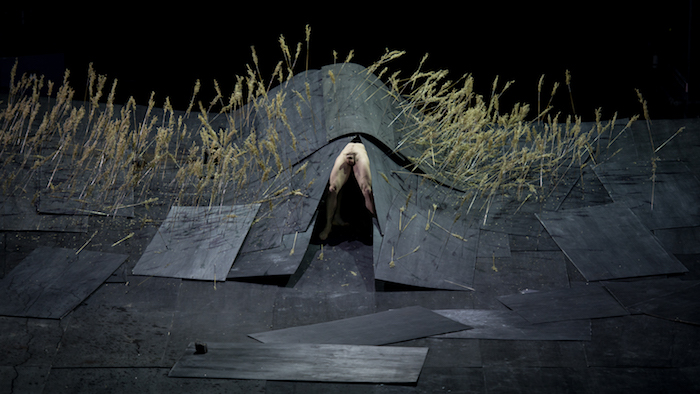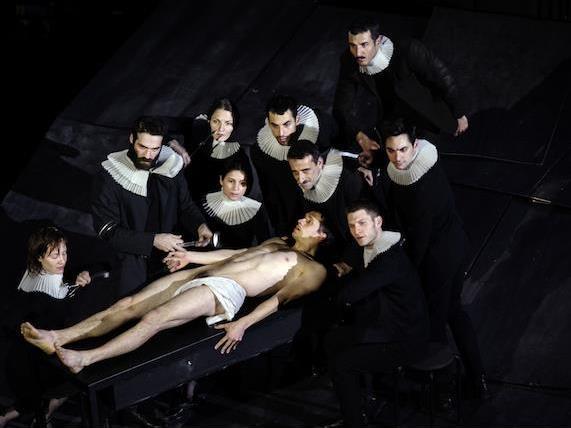Photo: Julian Mommert.
The Australian premiere of The Great Tamer is considered a coup for the Perth Festival, an iconic work by Dimitris Papaioannou, which has been acclaimed internationally since it was created in 2017.
While Papaioannou is best known as having created the artistic vision for the 2004 Athens Olympic ceremonies and the first European Games Baku 2015, he has been altering the Greek arts scene for more than two decades with his unique blend of experimental dance, physical theatre and performance art.
It is no surprise, then, on viewing one of his productions, to learn that before moving to theatre, Papaioannou trained in the visual arts.
The Great Tamer not only is a visually dynamic piece of theatre, but takes many of its cues from art history. For example, Papaioannou gives us a tableaux version of Rembrandt’s iconic painting The Anatomy Lesson of Dr Nicolaes Tulp (1632), which moves from an anatomy study to cannibalism in Papaioannou’s hands.
We also see a repeated nod to Greek Classicism and a focus on the lean noble naked form of a male. From the Kouros, to Salvador Dali’s tale of Narcissus, where a dancer plays with his own reflection in a pool of water, to Atlas holding the earth on his shoulder, inverted by Papaioannou with the equally strenuous task of balancing atop a globe. Time collapses in on itself.
That knotty, surreal web of familiarity is further played out with the use of Johann Strauss’s An der schonen blauen Donau, Op. 314 (the Blue Danube waltz), modified by Stephanos Droussiotis and returning repeatedly like a hypnotic anchor across this production. It is both elixir and anthem.

Photo: Julian Mommert.
Despite these triggers and plays with collective memory and history, the genesis of The Great Tamer is very contemporary. Papaioannou recalls a news story of a young man bullied at university, who then went missing, to be found dead later with questions about whether his death was murder or suicide. It ‘left me with emotions that I didn’t know what to do with’, said Papaioannou.
As an audience member The Great Tamer presents us with that same feeling of confusion, wanting to feel connection and empathy, but derailed by logic.
But I am getting ahead of myself.
Audiences enter the theatre to see a black-suited figure on stage. He proceeds to undress and lies down, while another suited figure places a white shroud over him. Another enters, picking up one of the many graphite-coloured tiles that form the floor; then drops it, forcing the shroud to flutter aside exposing the recumbent male. This sequence is repeated numerous times.
The tone is set immediately with this production – our human compulsion to cover things up and then reveal them; history’s role to conceal and erase, and our need to make sense and frame things. Life is a perpetual cycle – largely driven by primal forces, and while we don’t always understand our actions, we continue them.

Photo: Julian Mommert.
Told by 10 performers-slash-dancers, this sequence of events lacks a conventional narrative. Many of the images presented are fractured, forcing audiences to work in the stitching together of understanding, which inevitably is never arrived at.
A great example early in the piece is the image of a female figure composed of a woman’s torso with each leg that of a male, moving across the stage in a crab-like crawl in high heels. It screams Marcel Duchamp.
In another moment, dismembered body elements are pulled from below – a leg here, an arm there – and at others times a clustered group of figures moves as if co-joined by a magnetic force. We are made to rethink our bodily connections. The capacity of these dancers to deliver these extraordinary gestures has to be saluted.

Photo: Julian Mommert.
The performers work with everyday props – shoes, plants, soil, a book, an orange – to create the unfamiliar. I was spellbound by the image of an astronaut moving across stage seemingly without gravity. She starts to pull back the stage’s surface, first pulling out moon rocks and then plucking out a limp male figure, aka giving birth.
I was equally spellbound – and disturbed – by another story of a male protagonist who seemingly inserts his hands quite violently into a woman’s stomach, as she contorts in “pain” before slowly falling back to the underworld.

Photo: Julian Mommert
Tina Tzoka’s set design is amazing for its simplicity and capacity to create these two worlds – one onstage and one below, again turning that world of mythology into reality. Composed of tiled panels that rise and swell, the dancers regularly punch through this structure and figures emerge from it; soil is dug out from its depths; a pool of water creates reflection from below, and at moments it wraps and shields the body.
The coup de theatre is the moment when a shower of golden darts are thrown, piercing the floor (a figure hides below) and creating a fertile field of grain – from violence to bounty. It is the ultimate image of life cycles and renewal.

Photo: Julian Mommert.
This is not a short performance at one hour 40 minutes – and if it didn’t appeal to your theatrical tastes then that would feel epic. The Guardian described it as moving at a ‘zombie pace’.
On the flipside, if like me, you are pulled into this visual mosh of art history, mythology, life cycles, renewal and the surreal, Papaioannou’s blurring of genres and narratives is absolutely mesmerising and a must-see.
Papaioannou explained in an interview: ‘It’s my thirst to redefine and reinvent beauty and harmony; [that is] what matters to me. Not deconstruction’, adding that ‘I do not think that narrative alone is enough for theater. I don’t think anything alone is enough for art if the act of transformation is not achieved. If what I call alchemy is achieved, then no matter what the medium, it is enough.’
For me there was a sense of alchemy at play here. The Great Tamer, if just for two hours, allows you to dwell in a dreamspace that exists between worlds and beliefs. It suspends time and logic. While my guess is the appeal is very subjective, if you enjoy the contemporary collapse of mediums and formulated histories, then The Great Tamer will not disappoint.
Rating: 5 ★★★★★
The Great Tamer
Perth Festival
Produced by Onassis Culture Centre, Athens
Conceived and Directed by Dimitris Papaioannou
Dancers: Pavlina Andriopoulou, Costas Chrysafidis, Dimitris Kitsos, Ioannis Michos, Evangelia Randou, Kalliopi Simou, Drossos Skotis, Christos Strinopoulos, Yorgos Tsiantoulas, Alex Vangelis
Set Design & Art Direction: Tina Tzoke
Artistic Collaborator for Costumes: Aggelos Mendis
Costum and props Design: Maria Ilia
Lighting: Evina Vassilakopoulou
Artistic Collaborator for Sound: Giwrgos Poulios
Sound Design: Kostas Michopoulos
Music Adaptations: Stephanos Droussiotis
Sculpture Design: Nectarios Dionysatos
State Theatre Centre of WA
8-12 February 2019





